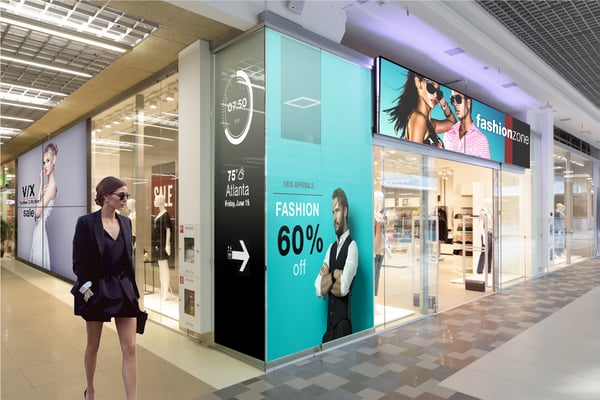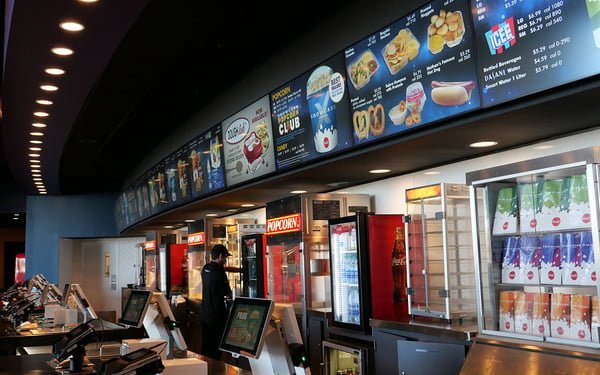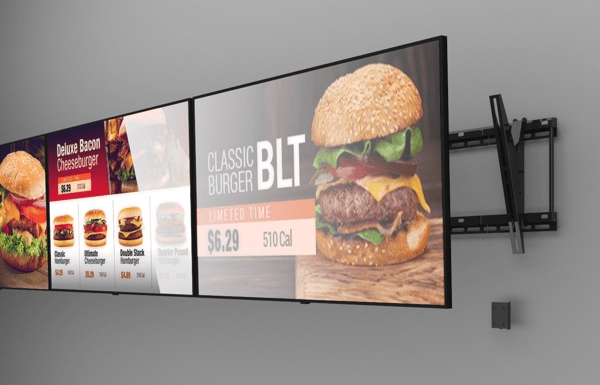Leveraging Dynamic Signage to Drive an Improved Customer Experience
Introduction
In today’s increasingly fast-paced world, companies are turning to innovative solutions to enhance the overall customer experience. One powerful tool that is reshaping the way businesses connect with their audience is digital signage. Dynamic digital signage has the potential to capture attention, deliver real-time information, and transform physical spaces into interactive environments. In this guide, we explore the myriad of ways businesses can harness dynamic signage to provide an unforgettable experience for their customers.
What is “Dynamic Signage”
Before we dive into some of the ways your business can leverage its signage to drive an amazing customer experience, let's start with defining what “dynamic signage” actually means.
We recently had a major player in the QSR space come to us and express their desire for “dynamic signage” in their restaurants. After a brief discussion, we realized that their definition of “dynamic” was different from the one we were using.
To some in the digital signage world, “dynamic signage” may refer to the use of motion and eye-catching graphics. To others, it means the ability to populate signage with “dynamic” (or “different”) content based on a variety of factors ranging from time of day to available inventory. The core impact of your signage on the customer experience will differ depending on how your business defines the word “dynamic.” Keep that in mind as your business discusses its signage plans in the future.

The Impact of Dynamic Content Population
Let’s start our discussion of dynamic signage using our definition of the term: digital signage that is populated by information that can change based on a predefined condition.
Display Real-Time Information and Adapt AccordinglyPerhaps the most compelling benefit of digital signage is its ability to display real-time information, such as updates, news, and promotions. This keeps customers informed and engaged, providing them with relevant and timely content that adds value to their experience. Digital signage’s adaptability empowers businesses to respond quickly to changing circumstances or promotional activities, and ensure their customers are in the loop as well.
Adaptable menu boards are a great example of displaying real-time information. For example, if your quick-service restaurant runs out of a particular ingredient, your business can use your menu board software to easily remove any impacted menu items from the boards. This reduces customer confusion and disappointment if they attempt to order something, only to be told that it is not available.
Another potential menu board tweak is pricing updates. Many of our clients are currently utilizing “surge pricing” to adjust prices if demand is very high at a particular point in time.
Keep your eyes peeled for other potential dynamic menu board adjustments in the future. One idea we’ve seen companies experiment with is automating promotion generation based on any expiring inventory. For example, if a store has ingredients that are going to go bad in a few days, your signage CMS, working closely with your point-of-sale and inventory tracking solutions, may be able to generate promotions like a “buy one get one free.” This would enable your business to stimulate sales of certain items ahead of the expiration of any key ingredients.
Venue-Wide AlertsAnother great use of dynamic content population could be in the theme park or stadium sector. If your venue has to communicate a message to the entire park or stadium, digital signage enables you to easily disseminate that message across all of your screens. This is particularly useful for emergencies like missing children, or bad weather.
Social Media IntegrationMany businesses also take advantage of the dynamic nature of digital signage to integrate with their social media feeds, enabling them to display reviews in real-time. This is a great way to not only get your customers involved but to demonstrate social proof to other customers in your store.
Keep in Mind: It’s All Powered by the CloudCloud-based management is critical for effective digital signage. Without the ability to manage your signage from anywhere, your business will lack the dexterity to make sweeping adjustments across multiple locations in a uniform, organized manner. Your digital signage content management system should make it simple to adjust its signage across locations with the push of a button. Remember, every dynamic signage implementation is powered not only by great hardware and great on-screen content, but by an even better software solution behind the scenes.
See the DEEL Difference in Action
We recently helped Showcase Cinemas update the signage in all 22 of its US locations, replacing its aging display network with state-of-the-art installations that will greatly improve the visual experience for movie-goers while making signage management more efficient on the back end. Click below to learn more about this project.

The Impact of Stunning Visuals and Motion
Now, moving into another interpretation of what “dynamic signage” means. If you view “dynamic” as meaning “motion” and “creative displays”, when it comes to your signage you certainly aren’t alone. Here are some of the key ways that this component of your signage strategy can revolutionize the customer experience.
Augmented EngagementStudy after study has shown that digital signage is simply more attention-grabbing than traditional static signage and has a much more profound impact on its viewers. Undoubtedly, a big part of this ties back to the ability to use motion on your signage. Digital displays capture 400% more views than static displays, and have a recall rate of 83%, almost double the established retention rate for traditional advertising. This impact is also seen through the point of purchase, as digital signage is shown to increase the average purchase amount by nearly 30%. The impact of dynamic signage on customer behavior is undeniable and is a massive reason why so many companies have gone digital in the last few decades. Consumers simply engage more favorably with digital screens than they do with traditional signage.
Interactivity OpportunitiesDigital signage provides an excellent opportunity for customers to interact with the content being shown to them on screens. This can be particularly useful for queue management, especially in theme parks. No one likes to wait in long lines, but businesses are making this experience more palatable by including interactive games like trivia on their signage. This gives visitors something to do while they wait, greatly reducing their perceived wait time and creating a more favorable overall experience.
We also see retailers make use of interactivity on their screens. Malls across the country have digital kiosks where shoppers can better plan their day by finding the location of certain stores.
Businesses of all kinds also use their signage to conduct surveys and gather feedback. This real-time data helps businesses understand customer preferences, concerns, and expectations, enabling them to make informed improvements for a better overall experience.
Branding and AtmosphereImplementing dynamic signage can have a massive impact on how a consumer perceives a brand. Customizable content, including brand visuals and videos, helps create a cohesive and immersive environment that aligns with a brand’s identity, leaving a lasting impression on customers. This is especially important in venues like movie theaters or theme parks where the “spectacle” of an event and your surroundings contribute heavily to the quality of your experience. Beyond improving immersion with engaging content, leveraging digital signage positions your brand as an industry leader. We have had many clients tell us their customers view their business as more upscale, and even their stores as being more clean after implementing their signage. This shows the massive impact that a proper signage initiative can have on customers’ perception of your business.
If customers have a favorable opinion of your brand and their experience, they are more likely to return. Every business should strive to create repeat customers who become advocates for your brand, helping it grow not only from a revenue perspective but from a visibility and trust perspective as well.
DEEL Media: Live in Action
Skeptical that digital signage can massively impact the atmosphere of a venue? Check out a recent implementation project we rolled out for Showcase Cinemas
Navigating environments like malls, airports, or large retail spaces can be challenging, especially for visitors in unfamiliar locations. Digital signage can help improve wayfinding with interactive maps and directional information guides that help customers locate their destinations, reducing confusion and enhancing overall satisfaction.
Promotions and UpsellingAs we mentioned earlier, dynamic visuals and animations are more compelling than static displays, making it easier to capture customers' interest and influence purchasing decisions. Dynamic signage provides an excellent opportunity for your business to highlight the most compelling offers.
You see this all the time in movie theaters, which often utilize captivating lobby takeovers and coordinated signage displays to promote big releases. Rich multimedia content can convey the excitement and details of events, generating buzz and encouraging customers to explore additional offerings.
On a small scale, the use of motion on menu boards can be incredibly potent for driving upsells and success for particular promotions. Motion that is easy on the eyes and follows a smooth rhythm can make it very easy for an eye to follow visuals across a board, drawing them to the higher-margin offers your business wants to focus on.
You can make your promotions even more effective when you factor in the other side of the coin when it comes to the “dynamism” of signage. Signage that can automatically populate with custom promotions based on factors like time of day and weather provides your business with a unique opportunity to take advantage of the demand for a particular product at a particular moment. Not only does this help drive more sales, it improves the customer experience by meeting the desires and preferences of your customers.

Conclusion
The next time your business notes its need for “dynamic” signage, make you frame the discussion properly. There are multiple ways to define dynamism, whether that be the ability to populate your signage with relevant content based on predetermined factors, or the use of motion to attract attention and captivate viewers. Both of these capabilities make digital signage a remarkably powerful tool for driving improved customer experiences.
If your business is looking to reinvent its signage strategy, you’ve come to the right place. DEEL Media has helped industry giants like Pizza Hut, Universal Studios, and Regal Cinemas roll out comprehensive signage projects that have wowed countless customers. What makes us different from the rest? We are an end-to-end digital signage partner for your business. Whether you need assistance with software or hardware selection, installation planning and execution, or on-screen content creation, we have the expertise to deliver.
Join the countless businesses that have elevated their signage with DEEL Media. Schedule a free consultation to meet with our team and talk through your needs today, or give us a call at 770-619-1225.

.jpg?width=476&height=420&name=IMG_5957%20(1).jpg)